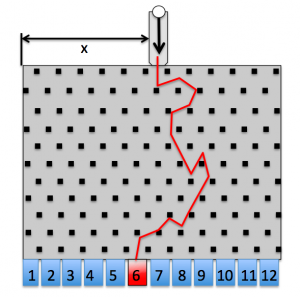Group 2
Chaos in Plinko
Inspired by the game Plinko featured on the popular American television gameshow The Price is Right, we set out to model the chaotic behavior of a puck under the influence of gravity traveling through and colliding with a regularly spaced lattice of cylindrical wooden pegs.
Background
Traditional studies of Plinko and other pinball billiard games have analyzed the aggregate statistics of the outcomes based on the starting position [1,2]. These analyses assume that each puck-pin interaction can only result in one of two possible outcomes: left or right. These analyses also assume that the puck must always continue downward without the possibility for upward motion, and they do not analyze the trajectory or starting conditions in detail.
More recently, work has been done to better understand the dynamics of pinball machines and pinball-like games where the collisions are not purely elastic [3,4,5]. These studies look at the real dynamics of the pinball game, including studying the chaos inherent in the system. As Plinko is essentially a pinball billiard game (partially elastic peg collisions and boundary interactions), it also demonstrates similar dynamics to classical billiard and pinball systems. It is thought to show rich, chaotic dynamics (sensitivity dependency upon initial conditions, mixing, etc) and be an interesting problem to demonstrate both a chaotic mapping of initial to final state and how two similar starting positions produce vastly different trajectories.
Experiment
Our experimental protocol consists of two parts. A physical modeling and analysis with a plinko board constructed of low cost material and simple point tracking with labview and Matlab. The second is a numerical simulation coded in Matlab to study the dynamics of the system upon simple changes in starting parameters and collision elasticity.
Physical model
The constructed plinko board will be built from low cost materials. Wood is an easy choice for the back of the board, while a clear plexiglass front will be necessary to track the path of a puck upon entering the lattice of pegs. A ping pong ball is chosen due to its low cost, and light weight. A notional diagram showing the setup of the experiment is seen in the figure.
The experiment will be conducted by dropping the ball into the device from a known starting position. The end state will then be mapped to the starting position. The puck will be dropped from a position on a pre-determined grid using a device that drops the puck without imparting any initial velocity or rotation (such as a tube with a bottom that drops out). The physical experiment will be conducted on the order of 100 times to form a coarse grid for comparison with the numerical simulations. A more concentrated series of drops may also be performed in regions of rich chaotic dynamics to verify sensitivity shown in the numerical simulation. <videoflash>mPU7QFlqXu8</videoflash>
Numerical simulation
The numerical simulation will be built in MATLAB and will use rigid body dynamics to simulate the collisions between the puck and the pegboard. The collisions will be modeled as elastic collisions with an optional parameter to modify the angle of reflection to produce modified, pinball-billiard dynamics (and thus create the possibility for attractors and more interesting dynamics, Markarian and Sanders). Using this simulation, we will model the physical layout of the Plinko board as shown in the figure.
The simulated Plinko model will be used to generate a finely-detailed mapping of initial position to final position. Final positions will be discrete bins that the puck may fall into. The initial position will be a combination of lateral starting position (distance from the static wall) and vertical position (speed at first peg impact). The numerical simulation will be run on the order of 1,000-10,000 times for both pure elastic and modified elastic collisions (based on run time) to calculate the mappings. Several values for the inelastic damping constant will be used, from a very small effect to a large effect on angle of reflection of the puck.
Analysis of Results
Analysis of the results will compare the two assumptions used in numerical simulation (elastic and modified elastic collisions) with the results of the physical trials in order to validate and compare numerical models, and to create a map of the initial state to the final state. A comparison between the results from the physics-based simulation and the traditional, probabilistic model will be performed, with special emphasis on looking at how multiple computer runs from different starting heights effects aggregate results and on the similarity between the deterministically-calculated trajectories and the probabilistic trajectories.
References
[1] http://phet.colorado.edu/en/simulation/plinko-probability. Plinko Probability. University of Colorado Active Simulations.
[2] Biesterfeld, A. “The Price (or Probability) Is Right.” University of Colorado at Boulder. Journal of Statistics Education. Volume 9, Number 3 (2001).
[3] Pring, S. R. Budd, C. J. “The Dynamics of a Simplified Pinball Machine.” University of Bath. IMA Journal of Applied Mathematics. 2011.
[4] Markarian, R. Pujals, E. J. Sambarino, M. “Pinball Billiards with Dominated Splitting.” Ergod. Th. & Dynam. Sys. Cambridge University Press. 2010.
[5] Arroyo, A. Markarian, R. Sanders, D. P. “Bifurcations of Periodic and Chaotic Attractors in Pinball Billiards with Focusing Boundaries.” Nonlinearity. IOP Publishing. 2009.

